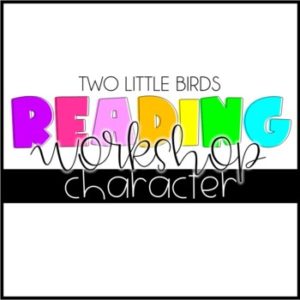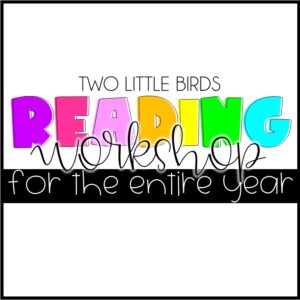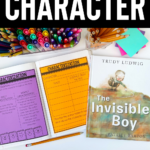Teaching characters to students in upper elementary grades starts to get more complex than the character traits taught in primary grades. We not only think about using adjectives to describe the characters, but we dig deeper into analyzing the characters, making connections to them, feeling empathy for them, making inferences about them, and seeing how characters can change over time.

Teaching character relies heavily on making inferences. So much of what we know about characters in stories stems from our own prior knowledge…an author usually does not say that a character feels left out or that a character is naughty, but students know how that feels or looks and they use the evidence in the text to make inferences about the characters.
It is so important to begin with an understanding of character. When students begin making inferences about characters, they have a better understanding of the characters in the story. They are able to use evidence from the text to make inferences and show a better understanding of the story.
Moving beyond simply using adjectives to describe characters is no easy task and one that you will continue to develop throughout the year. As students begin to understand characters as complex personalities, their comprehension and understanding will grow.
1. Identifying character traits
Identifying character traits is an important foundational skill. An important part of identifyig character traits is determining the difference between character traits and emotions. Character traits show the character’s personality. We use adjectives to describe the character’s actions, words, and thoughts.
Character emotions show the character’s feelings and response to things and actions around them. We analyze how the character responds to events.
“The Invisible Boy” is a great book to use to demonstrate and teach character traits because of the character development and variety of characters in the story.
On sticky notes, have students write down words or phrases to describe the characters in the book. create an anchor chart and have students decide whether their description is a trait or an emotion.
2. Characterization
Authors carefully develop characters throughout a story and reveal their character traits to the reader in different ways. I love using the character of Brian from “The Invisible Boy” because of the character development and the way Trudy Ludwig uses the illustrations as characterization too.
Characterization is how the author reveals the personality of the character throughout the story. Direct characterization is when the author directly tells the reader the character’s traits using adjectives to describe the character. Indirect characterization is when the author gives us clues throughout the story so that we can draw conclusions about the character. The author gives clues about the characters through their actions, thoughts, dialogue, and interactions with other characters.
The indirect characterization that the author uses through the illustrations gives clues about the type of character Brian is and how he feels throughout the story. It’s truly an amazing book to use with the way that Brian develops along with the color in the illustrations.
3. Types of characters
There are different types of characters in stories. Students can easily identify the main characters that we know a lot about and the supporting characters that also play a role in the story. But you can dig even deeper into the types of characters that authors include in their storytelling.
- Round characters: these are the characters that we know a lot about, the main characters.
- Dynamic characters: these characters go through a change throughout the story, many times the round characters are also the dynamic characters.
- Flat characters: these are the characters that we don’t know much about but they still play an important part in the story.
- Static characters: these characters do not go through a noticeable change, many times the flat characters are also static characters.
When we write about characters in the story, we choose the round, dynamic characters to write about because we know more about them and their thoughts and feelings. We are able to connect to them more because we know more about them.
If you have readers that are struggling with understanding characters and the more complex ways you are studying characters, find a story/character that is of interest to the student. A character that has the same interests, features, hobbies, etc. may be more engaging to the student. Think aloud as you read a selection from the book/passage with the student. What connections can you make? Encourage the student to do the same. How do you feel about the character’s choices or actions? What about how others are treating the character? What would you do if you were the character or the character’s friends/family? Ask for words that the author uses to help describe the character. Visualize and sketch pictures of the character together.
You will soon see your students' understanding and connections to characters grow beyond just describing them. Your discussions and reflections about character will help your students with other skills throughout the year.
You might also like to read these posts:
How to Teach Students to Make Meaningful Predictions
Making a Movie in Your Mind: Strengthening Comprehension with Visualizing
Reading Workshop: How to Keep Your Mini-Lesson Focused













